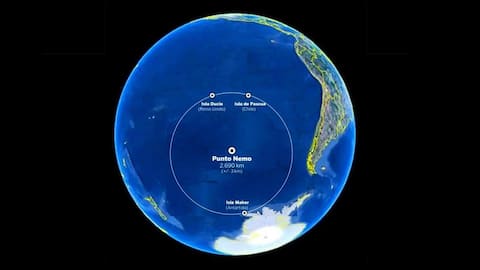Exploring Point Nemo: The remotest place on earth
What's the story
Deep within the vast expanse of the ocean lies a geographic anomaly known as Point Nemo, an invisible spot. This enigmatic location is distinguished by its utter remoteness, devoid of any landmass for thousands of kilometers in every direction. Despite its isolation, Point Nemo has garnered intrigue as a graveyard for spacecraft, a haven for scientific exploration, and the subject of mythical sea creatures.
Farthest point from the land
Pinnacle of isolation
Point Nemo, situated in the South Pacific Ocean, lies an astonishing 2,688 kilometers away from the closest landmass, Ducie Island, part of the Pitcairn Islands (located approximately midway between Peru and New Zealand) and over 2,415 kilometers from any other significant landmass. This makes Point Nemo the remotest place on earth with an unparalleled sense of isolation and inaccessibility in the vast ocean.
Many islands
Devoid of human presence
Nearby islands such as Motu Nii and Maher Island, standing solitary off the coast of Marie Byrd Land in Antarctica, stand as remote outposts devoid of a human presence existing in isolation amidst vast expanses of ocean. Journeying to the nearest signs of habitation requires undertaking a challenging sea voyage, whether to New Zealand, approximately 4,023 kilometers distant, or to Easter Island.
Lengthy boat journey
Astronauts closest
Easter Island, positioned approximately 3,540 kilometers west of Chile, represents the nearest hint of civilization to Motu Nii and Maher islands. Accessing Easter Island requires a lengthy boat journey that could span over two weeks due to the considerable distance across the open ocean. Remarkably, the closest individuals to Point Nemo are astronauts aboard the International Space station in space.
Cemetery
Space graveyard
The area's vast expanse of ocean ensures that any remnants of decommissioned spacecraft returning from space, such as satellites or space stations like the Mir and Tiangong-1, can safely crash into the water without posing a threat to populated areas. The controlled re-entry of these vehicles reduces the risk of potential harm to human life, making Point Nemo an ideal resting place.
In literature
Featured in fiction
Point Nemo's mystique and isolation have captured the imaginations of writers, filmmakers, and adventurers alike. Authors such as H.P. Lovecraft and Jules Verne have featured Point Nemo in their works of fiction. Lovecraft's "Cthulhu," a cosmic being, is believed to reside in a sunken city at Point Nemo. The location's extreme remoteness and frigid depths make it an ideal habitat for such a creature.
Bloop
Mysterious sound
In 1997, the National Oceanic and Atmospheric Administration (NOAA) in the United States detected a remarkably loud sound emanating from Point Nemo. This mysterious sound, named "bloop," wasn't confined to NOAA's observation alone and reverberated across the vast expanse of the Pacific Ocean. Following thorough analysis and numerous experimental investigations, scientists unveiled it as a sequence of low-frequency, high-amplitude signals at irregular intervals.
Not a Disney character
The island is not named after Nemo the fish
Point Nemo's etymology is often misconstrued with Disney's character, Nemo, from "Finding Nemo." While both Nemo the fish and Nemo the geographical feature draw inspiration from the sea, their similarities end there. Point Nemo got its name from Captain Nemo in the book 20,000 Leagues Under The Sea. It means "no man" in Latin because it is a lonely place, far from people.
